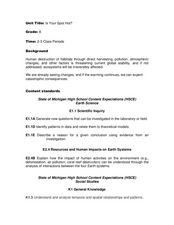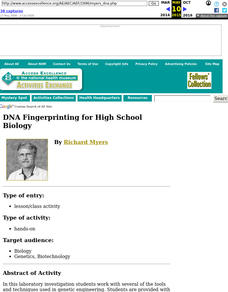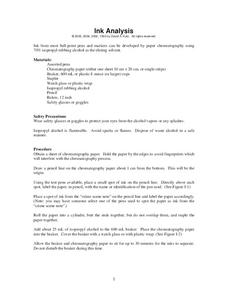University of Colorado
Patterns and Fingerprints
Human fingerprint patterns are the result of layers of skin growing at different paces, thus causing the layers to pull on each other forming ridges. Here, groups of learners see how patterns and fingerprints assist scientists in a...
Cornell University
Forensic Science: Case of the Missing Diamond Maker
Someone stole a diamond-making machine. Who done it? Scholars use forensic science at six different stations to determine the culprit. They analyze fingerprints, use their senses, and complete chemistry experiments to determine the...
Curated OER
Human Fingerprints: No Two the Same
Sixth graders explore scientific observations by analyzing a group of data. In this fingerprint identification instructional activity, 6th graders identify the reasoning behind fingerprinting and create their own ink fingerprints....
Curated OER
DNA Fingerprinting
Students discuss DNA Fingerprinting and gel electrophoresis before participating in a crime solving activity. Students simulate their DNA using adding tape and complete the steps necessary to do a gel electrophoresis. They discuss the...
Curated OER
Innocent or Guilty: A Lab on DNA Gel Electrophoresis
Students use the prelab as an introduction to the importance of DNA fingerprinting- a form of identification that us being accepted by both scientific and leagl experts. They prepare a gel for electrophoresis. DNA fragments, which have...
Curated OER
DNA Fingerprinting
Students study the process of DNA Fingerprinting and how DNA Fingerprinting is used in solving crimes. They examine a crime scenario that involves collecting DNA Fingerprinting information from blood collected at the crime scene. They...
Curated OER
Fingerprints
Students analyze their fingerprints. In this fingerprint lesson, students make prints and observe the patterns for arches, loops, and whorls. They write a brief autobiography about themselves titled "I'm Thumbody."
Curated OER
"Who Done It?" Analysis of Molecular Fingerprints Left At the Scene of the Crime
Young scholars examine different types of DNA fragments. They record and analyze their results. They determine who is the criminal in the story.
Curated OER
Who Done It?
Pick and choose which activities to include in this crime scene investigation. Junior detectives can examine fingerprints, DNA, blood samples, or bone structure. The plan suggests you have teams solve a mystery, but it does not...
Curated OER
Fingerprinting
Learners create a fingerprint card of each of their fingers using a pencil, special paper and tape. A comparison is made with their fingerprints to that of their classmates. They have to analyze how the prints are similar and different.
Curated OER
Is Your Spot Hot?
Eighth graders explore global warming. In this Earth Science lesson plan, 8th graders will look for Harbingers and fingerprints for different areas. The students will identify an area at risk and they will then create a...
Curated OER
My Science Box: DNA Fingerprinting
Young scholars identify DNA in a crime scenario. In this DNA lesson, students perform paper chromatography and compare it against the pens of various suspects.
Curated OER
DNA Fingerprinting with Restriction Enzymes
Students will illustrate how restriction enzymes work by piecing together parts of a puzzle. Then they apply this knowledge to help them analyze genetic evidence from the scene of a crime as well as to help them comprehend how a DNA...
Curated OER
DNA Fingerprinting for High School Biology
Students work with tools and techniques used in genetic engineering. They dissect a sample into fragments of DNA using restriction enzymes, sometimes called "molecular scissors". They sort these fragments, measure and analyze them according
Beyond Benign
Who’s Your Daddy? Finding the Father
Time for the reveal! The nineth lesson plan of the series of 18 has scholars compare DNA fingerprints of cats to their samples to identify the father of Sparky's kittens from previous lessons. They analyze the DNA bands to determine the...
Curated OER
Fingered Felons
Students examine fingerprints. In this biology lesson, students use sticky tape to create their own set of prints and identify patterns on each of their fingers. Students try to solve a "classroom crime" based on the patterns of a...
Curated OER
Forensic Detectives: Who Did It?
Students explore forensic science and its uses in criminal investigations. They solve a fictional crime by identifying and analyzing the fingerprints, strand of hair, and thread samples for evidence. After completing charts for each,...
Curated OER
DNA Fingerprinting with Gel Electrophoresis
Young scholars use DNA fingerprinting to demonstrate the concept that DNA fingerprinting can be used to identify individuals and solve problems. They use gel electrophoresis to analyze the DNA of a suspected criminal to prove innocence...
Cornell University
Plant Cell Crime Scene
Use science to solve the mystery of the Poplar murder. Pupils use forensic botany to determine if a suspect could be the killer. By analyzing images from a Transmission Electron Microscope, learners determine if the material found on the...
Curated OER
DNA Detectives
In order to understand DNA fingerprinting, advanced biology aces divise a crime scenario and analyze three different samples of lambda DNA. This creative lesson plan provides practice with micropipettes, electrophoresis boxes, and other...
Curated OER
Ink Analysis
High school chemistry class members become "detectives for a day" and use the concept of paper chromatography to analyze a note left at the scene of a crime. Pupils test the ink on the note with a solvent, such as isopropyl alcohol, to...
Curated OER
DNA Fingerprinting through a Chemistry Lens
Students explore DNA and restriction enzymes using fragments of DNA separated by electrophoresis on an agarose gel. They analyze the results to see "whodunit".
Curated OER
Shellfish Shenanigans
Twelfth graders create simulations of a reality-based TV show that investigates the near death of a contestant from a seafood meal. They examine the physical symptoms of anaphylactic shock, and create protein fingerprints.
Curated OER
Solving Imaginary Crimes
High schoolers participate in a forensic science activity. In this crime solving lesson plan, students investigate fingerprints, and other crime scene evidence to solve an imaginary crime.

























